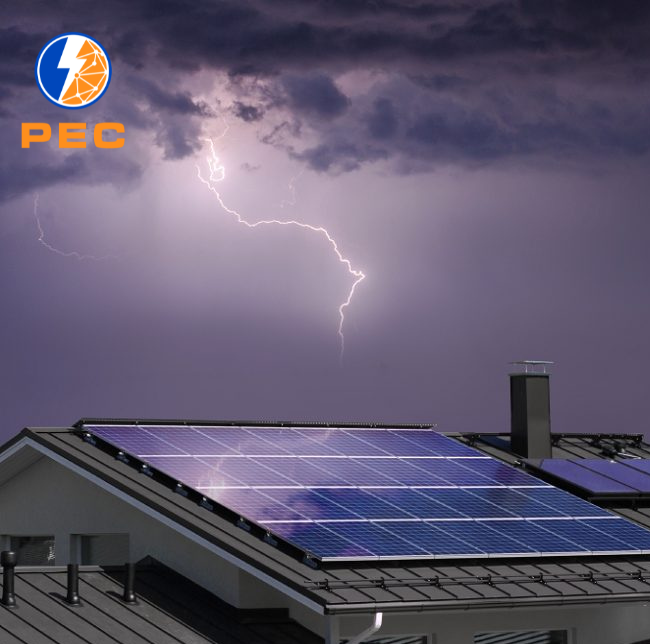1. Why Is It Necessary to Protect Solar Power Systems During the Stormy Season?
Vietnam lies in a tropical monsoon region and experiences frequent heavy rains, storms, and tropical depressions every year. These extreme weather events can directly affect solar power systems by damaging solar panels, causing short circuits in wiring, harming inverters, or reducing overall operational efficiency.
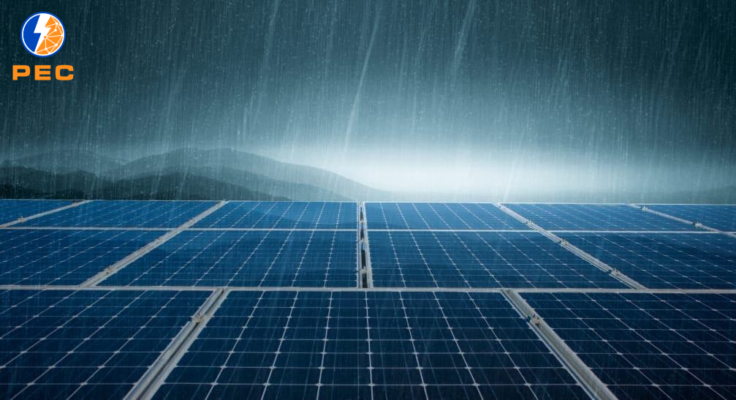
Therefore, preparing protection solutions for the system not only ensures the safety of the equipment but also gives users peace of mind in operation, while maintaining investment efficiency throughout the project’s lifecycle.
2. Common Risks Solar Power Systems Face During the Stormy Season
Although solar power systems are designed to be durable, they still face multiple risks during heavy rain and storms, specifically:
- Strong winds and heavy rain: may loosen or damage mounting structures, break solar panels, or even blow them off rooftops.
- Flooding and water leakage: directly affect cables, junction boxes, inverters, and electrical cabinets if not properly waterproofed.
- Direct or induced lightning strikes: can damage the entire system, cause fires or explosions, and significantly reduce the lifespan of electronic components.
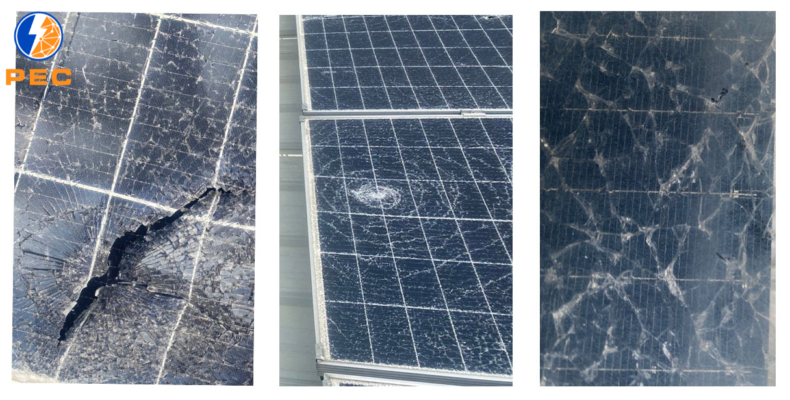
Identifying these risks early allows users to proactively implement protection measures and minimize potential damage as the storm season approaches.
3. Solar Power Protection Solutions During the Stormy Season
3.1. Reinforcing Mounting Structures and Solar Panels
The mounting structure bears the greatest impact from storms and strong winds. Therefore, it should be thoroughly inspected, with bolts tightened and critical points reinforced. In areas frequently affected by strong winds, hot-dip galvanized steel or aluminum alloy should be used to ensure durability and corrosion resistance.
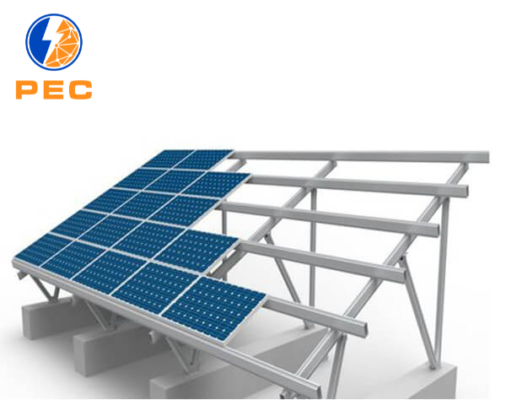
Solar panels must be installed in accordance with technical standards, with an appropriate tilt angle to both optimize performance and reduce wind pressure. When securely fixed, the system can minimize the risk of overturning, displacement, or damage during storms.
3.2. Waterproofing and Protecting Cables
Rainwater can seep into connection points or small gaps, causing short circuits and equipment damage. Therefore, users should ensure that all cables are routed through protective conduits that are UV-resistant and capable of withstanding humid environments.
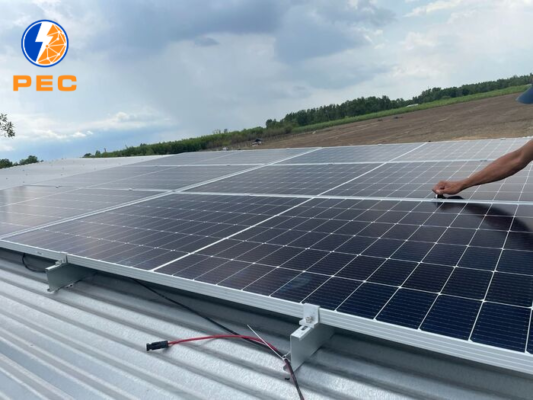
Junction boxes, electrical cabinets, and inverters should be placed in elevated, well-ventilated locations and equipped with an IP65 rating or higher to resist water and dust. This is a critical factor in ensuring system safety, especially during prolonged periods of heavy rain.
3.3. Regular Inspection and Maintenance
No matter how high the quality of a solar power system is, it still requires regular inspection and maintenance to ensure safety, particularly before and during the stormy season. This allows small issues to be detected and addressed promptly, preventing them from developing into major problems.
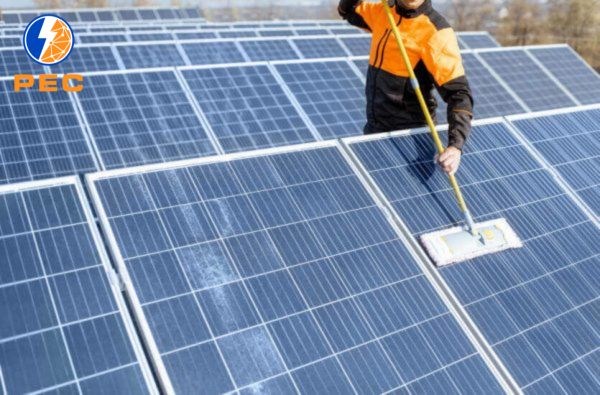
Items that should be inspected regularly include:
- Mounting structures and bolts: tighten and replace if signs of rust or looseness are detected.
- Cables and junction boxes: ensure insulation layers remain intact; repair immediately if cracks or exposure are found.
- Solar panel surfaces: clean regularly to remove dust, leaves, or bird droppings, improving water drainage and light absorption.
- Inverters and electrical cabinets: place in dry, clean areas to prevent high humidity that could cause short circuits or reduce component lifespan.
Carrying out regular maintenance helps the system operate stably, minimizes risks during the stormy season, and enhances long-term power generation efficiency.
3.4. Installing Lightning Protection and Electrical Safety Systems
Lightning poses a major hazard to elevated structures, especially rooftop solar power systems. To mitigate risks, equipping the system with proper lightning protection and electrical safety measures is a mandatory solution.
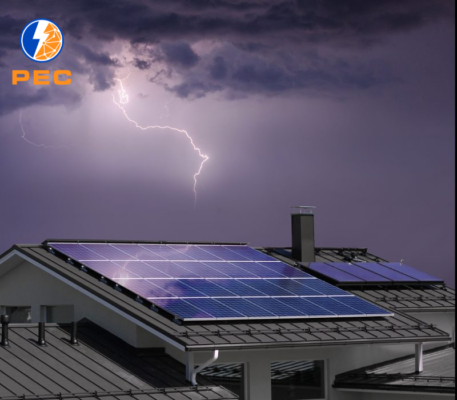
The essential devices to be installed include:
- Lightning rods and grounding wires: conduct lightning currents directly into the ground, preventing damage to solar arrays.
- Surge Protection Devices (SPD): installed in electrical cabinets to block overvoltage from spreading to inverters and the household electrical system.
- MCBs and automatic circuit breakers: instantly cut off power in the event of overloads or leakages, protecting both equipment and user safety.
Compared to the total investment cost, this item accounts for only a very small proportion but delivers long-term safety value, ensuring the system operates stably even during stormy weather.
3.5. Choosing a Reliable Installation and Maintenance Provider
A key factor for a sustainable solar power system is selecting the right contractor for installation and maintenance. A trusted provider not only guarantees design and installation in compliance with technical standards but also offers regular inspections and timely troubleshooting when issues arise.
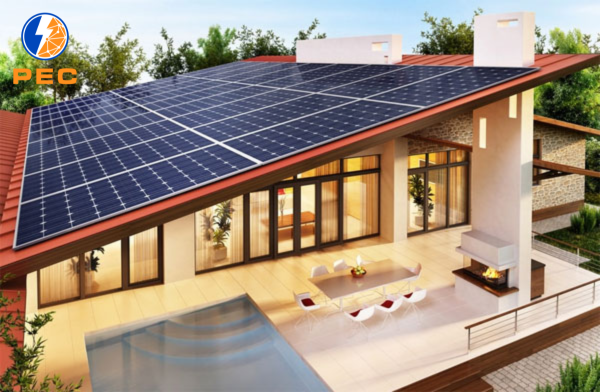
Key criteria when selecting a contractor include:
- Proven experience with solar power projects of various scales.
- A team of highly qualified engineers with strong knowledge of electrical safety and construction standards.
- Clear maintenance and warranty services, with commitments to provide prompt support when needed.
Hoa Binh Energy Construction Consulting Co., Ltd. (PEC) is one of the pioneers in the solar energy sector in Vietnam. With many years of experience and a team of highly skilled engineers, PEC has successfully implemented hundreds of solar projects for households, businesses, and factories. We are committed to delivering safe, sustainable, and long-term effective solutions, ensuring peace of mind for customers even during harsh stormy seasons.
Conclusion:
Solar panels are completely safe during the stormy season if the right products are chosen, installed professionally, and maintained regularly. Furthermore, partnering with a trusted contractor like Hoa Binh Energy Construction Consulting Co., Ltd. (PEC) will provide you with a high-quality, stable, and sustainable solar power system for many years to come.
Contact Information:

Hoa Binh Energy Construction Consulting – PEC
Address: No. 5 Street 6B, Binh Tan Ward, Ho Chi Minh City.
Mail: office@pec.vn
Hotline: 1900 98 98 91

 Tiếng Việt
Tiếng Việt
